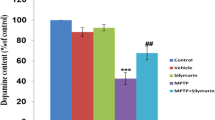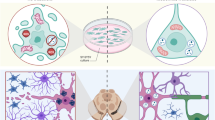Abstract
Parkinson’s disease (PD) is the second most familiar, progressive and movement-related neurodegenerative disorder after Alzheimer disease. This study aimed to decipher the role of autophagy in cypermethrin-induced Parkinsonism, an animal model of PD. Indicators of autophagy [expression of beclin 1, autophagy-related protein 12 (Atg 12), unc-51 like autophagy activating kinase 1 (Ulk 1), p62 and lysosome-associated membrane protein 2 (LAMP 2) and conversion of microtubule-associated protein 1A/1B-light chain 3 (LC3) I to II], signalling cascade [phosphorylated (p) 5′ adenosine monophosphate-activated protein kinase (p-AMPK), sirtuin 1 (Sirt 1), phosphorylated-mammalian target of rapamycin (p-mTOR), tuberous sclerosis complex 2 (TSC 2), p317Ulk 1 and p757Ulk 1 levels] and lysosome morphology were assessed in control and cypermethrin-treated rat model of PD. Autophagy markers were also measured in cypermethrin-treated neuroblastoma cells in the presence of 3-methyl adenine, a phosphatidylinositol-4,5-bisphosphate 3-kinase (PI3K) class III inhibitor; vinblastine, an autophagosome elongation inhibitor; bafilomycin A1, an autophagolysosome and lysosome fusion/abnormal acidification inhibitor or torin 1, a mechanistic target of rapamycin inhibitor. Cypermethrin reduced LAMP 2 and increased p-AMPK and Sirt 1 without causing any change in other signalling proteins. 3-Methyl adenine did not change LC3 conversion; vinblastine and bafilomycin A1 decreased LAMP 2 expression in controls. While cypermethrin increased LC3 conversion in the presence of 3-methyl adenine, LAMP 2 reduction was more pronounced in vinblastine and bafilomycin A1-treated cells. Torin 1 normalized the expression of LAMP 2 without any change in other autophagy markers. Results demonstrate that albeit cypermethrin activates autophagosome formation, it reduces LAMP 2 expression and lysosome quality leading to autophagy inhibition.







Similar content being viewed by others
References
Agrawal S, Dixit A, Singh A, Tripathi P, Singh D, Patel DK, Singh MP (2015a) Cyclosporine A and MnTMPyP alleviate alpha-synuclein expression and aggregation in cypermethrin-induced Parkinsonism. Mol Neurobiol 52:1619–1628
Agrawal S, Singh A, Tripathi P, Mishra M, Singh PK, Singh MP (2015b) Cypermethrin-induced nigrostriatal dopaminergic neurodegeneration alters the mitochondrial function: a proteomics study. Mol Neurobiol 51:448–465
Basu S, Rajakaruna S, Reyes B, Van Bockstaele E, Menko AS (2014) Suppression of MAPK/JNK-MTORC1 signaling leads to premature loss of organelles and nuclei by autophagy during terminal differentiation of lens fiber cells. Autophagy 10(7):1193–1211
Bove J, Martinez-Vicente M, Dehay B, Perier C, Recasens A, Bombrun A, Antonsson B, Vila M (2014) BAX channel activity mediates lysosomal disruption linked to Parkinson disease. Autophagy 10:889–900
Burbulla LF, Krebiehl G, Kruger R (2010) Balance is the challenge-the impact of mitochondrial dynamics in Parkinson’s disease. Eur J Clin Investig 40:1048–1060
Chen L, Xu B, Liu L, Luo Y, Zhou H, Chen W, Shen T, Han X, Kontos CD, Huang S (2011) Cadmium induction of reactive oxygen species activates the mTOR pathway, leading to neuronal cell death. Free Radic Biol Med 50(5):624–632
Cramer SL, Saha A, Liu J, Tadi S, Tiziani S, Yan W, Triplett K, Lamb C, Alters SE, Rowlinson S, Zhang YJ, Keating MJ, Huang P, DiGiovanni J, Georgiou G, Stone E (2017) Systemic depletion of L-cyst(e)ine with cyst(e)inase increases reactive oxygen species and suppresses tumor growth. Nat Med 23(1):120–127
Cuervo AM, Stefanis L, Fredenburg R, Lansbury PT, Sulzer D (2004) Impaired degradation of mutant alpha-synuclein by chaperone-mediated autophagy. Science 305:1292–1295
Dixit A, Srivastava G, Verma D, Mishra M, Singh PK, Prakash O, Singh MP (2013) Minocycline, levodopa and MnTMPyP induced changes in the mitochondrial proteome profile of MPTP and maneb and paraquat mice models of Parkinson's disease. Biochim Biophys Acta 1832:1227–1240
Dworak M, McCarley RW, Kim T, Kalinchuk AV, Basheer R (2010) Sleep and brain energy levels: ATP changes during sleep. J Neurosci 30(26):9007–9016
Ebrahimi-Fakhari D, McLean PJ, Unni VK (2012) Alpha-synuclein’s degradation in vivo: opening a new (cranial) window on the roles of degradation pathways in Parkinson disease. Autophagy 8:281–283
Giordano S, Darley-Usmar V, Zhang J (2013) Autophagy as an essential cellular antioxidant pathway in neurodegenerative disease. Redox Biol 2:82–90
Harlan FK, Lusk JS, Mohr BM, Guzikowski AP, Batchelor RH, Jiang Y, Naleway JJ (2016) Fluorogenic substrates for visualizing acidic organelle enzyme activities. PLoS One 11:e0156312
Hou YS, Guan JJ, Xu HD, Wu F, Sheng R, Qin ZH (2015) Sestrin2 protects dopaminergic cells against rotenone toxicity through AMPK-dependent autophagy activation. Mol Cell Biol 35:2740–2751
Kakko I, Toimela T, Tahti H (2004) The toxicity of pyrethroid compounds in neural cell cultures studied with total ATP, mitochondrial enzyme activity and microscopic photographing. Environ Toxicol Pharmacol 15:95–102
Klodowska-Duda G, Jasinska-Myga B, Safranow K, Boczarska-Jedynak M, Opala G (2005) The role of environmental factors in Parkinson’s disease may depend on disease onset age. Neurol Neurochir Pol 39:445–450
Lan DM, Liu FT, Zhao J, Chen Y, Wu JJ, Ding ZT, Yue ZY, Ren HM, Jiang YP, Wang J (2012) Effect of trehalose on PC12 cells overexpressing wild-type or A53T mutant alpha-synuclein. Neurochem Res 37:2025–2032
Lee J, Giordano S, Zhang J (2012) Autophagy, mitochondria and oxidative stress: cross-talk and redox signalling. Biochem J 441:523–540
Lowry OH, Rosebrough NJ, Farr AL, Randall RJ (1951) Protein measurement with the Folin phenol reagent. J Biol Chem 193:265–275
Ma B, Cao W, Li W, Gao C, Qi Z, Zhao Y, Du J, Xue H, Peng J, Wen J, Chen H, Ning Y, Huang L, Zhang H, Gao X, Yu L, Chen YG (2014) Dapper1 promotes autophagy by enhancing the Beclin1-Vps34-Atg14L complex formation. Cell Res 24(8):912–924
Mak SK, McCormack AL, Manning-Bog AB, Cuervo AM, Di Monte DA (2010) Lysosomal degradation of alpha-synuclein in vivo. J Biol Chem 285:13621–13629
Mishra AK, ur Rasheed MS, Shukla S, Tripathi MK, Dixit A, Singh MP (2015) Aberrant autophagy and Parkinsonism: does correction rescue from disease progression? Mol Neurobiol 51:893–908
Moors T, Paciotti S, Chiasserini D, Calabresi P, Parnetti L, Beccari T, van de Berg WD (2016) Lysosomal dysfunction and alpha-synuclein aggregation in Parkinson’s disease: diagnostic links. Mov Disord 31:791–801
Musiwaro P, Smith M, Manifava M, Walker SA, Ktistakis NT (2013) Characteristics and requirements of basal autophagy in HEK 293 cells. Autophagy 9:1407–1417
Niso-Santano M, Bravo-San Pedro JM, Gomez-Sanchez R, Climent V, Soler G, Fuentes JM, Gonzalez-Polo RA (2011) ASK1 overexpression accelerates paraquat-induced autophagy via endoplasmic reticulum stress. Toxicol Sci 119:156–168
Ozeki N, Hase N, Hiyama T, Yamaguchi H, Kawai R, Kondo A, Matsumoto T, Nakata K, Mogi M (2015) Interleukin-1β-induced autophagy-related gene 5 regulates proliferation of embryonic stem cell-derived odontoblastic cells. PLoS One 10(4):e0124542
Pan T, Kondo S, Le W, Jankovic J (2008) The role of autophagy-lysosome pathway in neurodegeneration associated with Parkinson’s disease. Brain 131:1969–1978
Plank TL, Yeung RS, Henske EP (1998) Hamartin, the product of the tuberous sclerosis 1 (TSC1) gene, interacts with tuberin and appears to be localized to cytoplasmic vesicles. Cancer Res 58(21):4766–4770
Richter EA, Ruderman NB (2009) AMPK and the biochemistry of exercise: implications for human health and disease. Biochem J 418:261–275
Sarkar S (2013) Regulation of autophagy by mTOR-dependent and mTOR-independent pathways: autophagy dysfunction in neurodegenerative diseases and therapeutic application of autophagy enhancers. Biochem Soc Trans 41:1103–1130
Sarkar S, Ravikumar B, Floto RA, Rubinsztein DC (2009) Rapamycin and mTOR-independent autophagy inducers ameliorate toxicity of polyglutamine-expanded huntingtin and related proteinopathies. Cell Death Differ 16:46–56
Singh AK, Tiwari MN, Dixit A, Upadhyay G, Patel DK, Singh D, Prakash O, Singh MP (2011) Nigrostriatal proteomics of cypermethrin-induced dopaminergic neurodegeneration: microglial activation-dependent and -independent regulations. Toxicol Sci 122:526–538
Singh AK, Tiwari MN, Upadhyay G, Patel DK, Singh D, Prakash O, Singh MP (2012) Long term exposure to cypermethrin induces nigrostriatal dopaminergic neurodegeneration in adult rats: postnatal exposure enhances the susceptibility during adulthood. Neurobiol Aging 33:404–415
Song L, Chen L, Zhang X, Li J, Le W (2014) Resveratrol ameliorates motor neuron degeneration and improves survival in SOD1(G93A) mouse model of amyotrophic lateral sclerosis. Biomed Res 2014:483501
Srivastava G, Dixit A, Yadav S, Patel DK, Prakash O, Singh MP (2012) Resveratrol potentiates cytochrome P450 2 d22-mediated neuroprotection in maneb and paraquat-induced Parkinsonism in the mouse. Free Radic Biol Med 52:1294–1306
Tripathi P, Singh A, Singh MP (2017) Ibuprofen protects from cypermethrin-induced changes in the striatal dendritic length and spine density. Mol Neurobiol. https://doi.org/10.1007/s12035-017-0491-9
Ur Rasheed MS, Tripathi MK, Mishra AK, Shukla S, Singh MP (2016) Resveratrol protects from toxin-induced Parkinsonism: plethora of proofs hitherto petty translational value. Mol Neurobiol 53:2751–2760
Viollet B, Horman S, Leclerc J, Lantier L, Foretz M, Billaud M, Giri S, Andreelli F (2010) AMPK inhibition in health and disease. Crit Rev Biochem Mol Biol 45:276–295
Webb JL, Ravikumar B, Atkins J, Skepper JN, Rubinsztein DC (2003) Alpha-Synuclein is degraded by both autophagy and the proteasome. J Biol Chem 278:25009–25013
Wu YT, Tan HL, Shui G, Bauvy C, Huang Q, Wenk MR, Ong CN, Codogno P, Shen HM (2010) Dual role of 3-methyladenine in modulation of autophagy via different temporal patterns of inhibition on class I and III phosphoinositide 3-kinase. J Biol Chem 285:10850–10861
Xie X, Zhang D, Zhao B, Lu MK, You M, Condorelli G, Wang CY, Guan KL (2011) IkappaB kinase epsilon and TANK-binding kinase 1 activate AKT by direct phosphorylation. Proc Natl Acad Sci 108(16):6474–6479
Xilouri M, Brekk OR, Stefanis L (2013) α-Synuclein and protein degradation systems: a reciprocal relationship. Mol Neurobiol 47:537–551
Zhang L, Fu L, Zhang S, Zhang J, Zhao Y, Zheng Y, He G, Yang S, Ouyang L, Liu B (2017) Discovery of a small molecule targeting ULK1-modulated cell death of triple negative breast cancer in vitro and in vivo. Chem Sci 8(4):2687–2701
Acknowledgements
The authors sincerely acknowledge the Council of Scientific and Industrial Research (CSIR), University Grants Commission and Department of Science and Technology India, respectively, for extending fellowship to Abhishek Kumar Mishra and Charul Rajput; Saumya Mishra and Mohd Sami ur Rasheed. The Science and Engineering Research Board (SERB), India (Project Reference No.: EMR/2016/005041), is gratefully appreciated for approving the study for financial support. CSIR-IITR communication number of this article is 3446.
Author information
Authors and Affiliations
Corresponding author
Ethics declarations
Animal study was performed as per the guidelines of CPCSEA, India.
Conflict of Interest
The authors declare that they have no conflict of interest.
Additional information
IITR Communication Number: 3446
Rights and permissions
About this article
Cite this article
Mishra, A.K., Mishra, S., Rajput, C. et al. Cypermethrin Activates Autophagosome Formation Albeit Inhibits Autophagy Owing to Poor Lysosome Quality: Relevance to Parkinson’s Disease. Neurotox Res 33, 377–387 (2018). https://doi.org/10.1007/s12640-017-9800-3
Received:
Revised:
Accepted:
Published:
Issue Date:
DOI: https://doi.org/10.1007/s12640-017-9800-3




